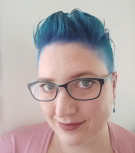In the first of a series of posts on editing fiction, Katherine Kirk looks at how editors can help authors create engaging dialogue that really brings individual characters to life.
Style manuals like New Hart’s Rules and guides like The Chicago Guide to Copyediting Fiction can help editors know exactly how to punctuate an interruption or how to capitalise a stammered first name, but there’s more to great conversations than the lengths of their pauses. Sometimes we need to dig a little deeper into them, and at a line editing level, this can start to feel a bit abstract. It can be hard to explain to an author how to add more subtext to a snippet of dialogue: ‘You need to not write more things not being said’ sounds like some kind of magic trick.
This post will look at how great dialogue starts with the character, it changes depending on whom they’re talking to, and how editors can add or subtract to bring those voices out.
Start with the character
If a novel’s characters aren’t distinct enough from each other, their voices will blur into one and the reader will soon forget who’s who and why they should care.
A strong character voice comes from who that character is at their core. Their background, their beliefs and their agenda all play into how they speak. If you’re working directly with an author, you can ask them probing questions like: ‘These characters live in the US but are originally from the UK, having moved there when the children were quite young. How much of their British accent has remained a decade later?’
The answers will inform word choice and what sort of rhythm the characters use when they speak. For that reason, I usually don’t wait until the end of my main pass through a manuscript to ask the author these types of questions, but send them along as soon as possible.
If you’re not working directly with an author, then you can only work with the information they’ve given you in the manuscript itself, which is why it’s a great idea to read the whole thing first, before editing. In your style sheet, make notes not only of the concrete details like a character’s age or hair colour but also about characteristics that could inform the way they speak. If they have a pet phrase or verbal habit, see if it’s used consistently. Does their spoken voice match their inner voice? Is there a good reason for it not to?
Paying attention to these aspects of the character’s voice can help you to pick up on where characters might start sounding the same. For instance, what maybe started as a verbal habit for one character might have been applied to multiple characters, nullifying its effect. Or it may be an author habit instead. If an author is relying only on these verbal habits to distinguish characters from each other, they might be overused and feel repetitive. Authors of YA may be tempted to have their teen characters say ‘like’ in every sentence; while this might reflect how some real-life teens speak, overuse may irritate readers. Don’t be afraid to suggest removing some of them.
Pet phrases aren’t the only tool we can use to make the voices more distinct. Some other options might be:
- talking around the issue vs getting to the point (look at sentence structure here)
- utilising gratuitously verbose lexical terms vs using short, simple words
- airily drifting in and out of a conversation with pauses and ellipses vs jumping in and thrashing about with dashes
- popping in slang vs using very ‘correct’ formal language. Regional slang, age-specific slang, and industry jargon can all tell us a lot about a person, and about a person who refuses to use it.
The roles we play
I am her mother, his wife, her teacher, his naughty little secret, their ally, your worst nightmare, and that will affect how I speak to you. People who know each other well develop a kind of shorthand and can read each other’s subtext better, so characters who are close might not need to have every question answered. I often find that deleting the answer to the question (especially a yes or no) loses nothing. The reader can infer the answer from context and how the conversation proceeds, and it feels snappier and more vivid.
Here’s an example with every question answered. Note how slow it feels.
‘Where is he?’ I asked, reaching for the frozen peas.
‘He’s out back, I think.’ She turned away, as if she couldn’t bear to look at me. ‘Are you hungry?’
‘I’m not hungry. The peas are for the swelling.’ I pressed them to my throbbing cheek. ‘Did you tell him?’
‘I didn’t tell him,’ she said. ‘I knew it would make him angry.’
‘Because you know how he gets,’ I muttered.
‘Yes. I know,’ she said. ‘That’s why I didn’t tell him.’
When the characters are family, as these two might be, then much of this does not need to be said. Cutting text out can turn it into subtext, making the conversation feel less stodgy and more suspenseful. If there’s a tag along with an action beat, we can probably take the tag out too and use the action beat as attribution on its own. Where it’s clear who’s speaking, we don’t need any attribution at all. Here’s an extreme example of how it might be pared down:
‘Where is he?’ I reached for the frozen peas.
‘Out back.’ She turned away. ‘I didn’t tell him.’
‘You know how he gets.’
‘I know.’
What if they were acquaintances?
‘Where is he?’ I reached for the frozen peas.
‘He’s out back. Working in the shop, I think.’ She turned away. ‘Did he do that?’
‘You couldn’t have known.’
‘I might have. But it wasn’t me that told him.’
Here, they need to give each other a little more information, and the shared knowledge of years of history is gone. They speak in slightly more complete sentences and give each other more grace.
How the characters negotiate the control of the conversation (or turn-taking) could also show their intimacy. It might change over the course of a novel. A meet-cute might have our lovers verbally stumbling over and butting up against each other, but by the end of their love story, they’re listening to each other, reading each other’s subtext and finishing each other’s sentences. Or it could go the other way, with a couple who used to be able to read each other’s signals now finding they’re no longer fluent in their shared unspoken language, and they might misread it.
What if our two characters dislike each other, and one of them is a little tougher? Let’s have the tough lady interrupt more and use more colloquial language, and contrast it with the other by having more hedging and hesitation. We might need to add an action beat to make the character more vivid.
‘Where is he?’ I reached for the frozen peas.
She spat out an apple seed. ‘I ain’t his keeper.’
‘Did you tell him? That I–’
‘Course not.’
‘It’s just that, well, I wouldn’t blame you if you had.’
‘Well I didn’t.’
Their relationship affects the words they choose to say, the questions they dodge and the assumptions they make. Dialogue that fails to take these elements into account tends towards soulless conversation that is just furthering the plot, reacting to an event or revealing a secret.
How much can an editor change?
It tends to be easier to take things out than to add things in. Whatever we remove, the words that remain are still entirely the author’s. Luckily for us, authors tend to bloat dialogue rather than be too brief, so we usually just need to do some careful snipping. But sometimes the dialogue feels like it’s just scaffolding and it needs something more substantial.
When it comes to adding stuff in, editors are limited in what we can do. It’s not our job to write the book. But we could provide examples. My favourite trick is to mine the narrative for key phrases that ring with the character’s voice and move them into sleepy dialogue to wake it up. I might borrow a phrase from one speaker and give it to another, or flip who says what. That way I’m using the author’s own words to patch the hole rather than speaking for them. If there isn’t a handy phrase nearby, I’ll provide some examples in my best imitation of their voice and let the author choose.
If you’re asking them to add something, you must have a good reason for doing so, and be very clear in your directions. Be specific about what exactly needs to be added, why and where. Review their revisions to check they haven’t introduced errors. And remember that it’s not your book.
Summing it up
- If you read a manuscript in full before you dive in, you can get to know the characters a little better.
- Take note not only of what characters are but who they are, and how that affects their voice.
- Make note of their relationships, and check if these relationships are reflected in their conversations.
- Trim out the unnecessary padding and let the best parts of the dialogue shine without being smothered by redundant dialogue tags or awkward attempts to show dialect.
- Be just as careful taking out as you are adding in, and don’t fix what ain’t broke. Ask more questions and respect the characters as much as you respect the author.
For more insight into making dialogue sparkle, I recommend Louise Harnby’s dialogue resources, this blog post by Emma Darwin, and Sophie Playle’s fabulous explanation of ‘As You Know, Bob’ dialogue (and how to avoid it).
About Katherine Kirk
Katherine Kirk is a fiction editor who has lived all over the world, including China, South Korea, Ecuador, and Morocco, and she’s not done yet. She works on all types of fiction for adults, especially Science Fiction, Fantasy and Literary Fiction. She is a Professional Member of the CIEP.
 About the CIEP
About the CIEP
The Chartered Institute of Editing and Proofreading (CIEP) is a non-profit body promoting excellence in English language editing. We set and demonstrate editorial standards, and we are a community, training hub and support network for editorial professionals – the people who work to make text accurate, clear and fit for purpose.
Find out more about:
Photo credits: speech bubbles by Miguel Á. Padriñán on Pexels; couple by Samson Katt on Pexels.
Posted by Sue McLoughlin, blog assistant.
The views expressed here do not necessarily reflect those of the CIEP.


